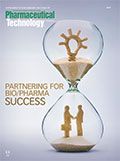Determining Drug Stability
Pharmaceutical Technology spoke with Lisa Crandall, MS, associate director CMC Project Management, and Peter Angus, PhD, director of Pharmaceutical Sciences, at Velesco Pharma, which provides a full range of stability testing of API and drug products, about best practices in stability testing.
Pharmaceutical Technology spoke with Lisa Crandall, MS, associate director CMC Project Management, and Peter Angus, PhD, director of Pharmaceutical Sciences, at Velesco Pharma, which provides a full range of stability testing of API and drug products, about best practices in stability testing.
PharmTech: Which methods are used to determine stability of a drug in early development? In later-stage development? Do these methods differ?
Velesco: In early development, typical API and drug product stability analysis include appearance, assay, related substances, and water. Additionally, depending upon type of drug product formulation being assessed, tests such as assay of preservatives and/or antioxidants, pH, viscosity, osmolality, particulates, antimicrobial effectiveness, and microbiological bioburden may be necessary. Specific methods such as high-performance liquid chromatography (HPLC) for assay/impurities are phase appropriate. In later development, the stability indicating techniques haven’t changed, but the specific methods have evolved with the product. Quantitation of known impurities is now possible.
PharmTech: What steps should be taken to ensure stability of a drug?
Velesco: To increase the chances that your drug is stable, it is vital to pay attention to all early data pertaining to the effects of temperature, humidity, light, polymorph, salt form, etc., as well as excipient compatibility and packaging. Discovering limitations and interactions early in development provides a better chance of success, especially in situations in which one polymorph is significantly more stable than others.
PharmTech: What mistakes do companies make in early development that could lead to instability?
Velesco: Common mistakes early in development are ignoring the importance of risk assessment using the philosophies in International Council for Harmonization (ICH) Q8 and Q9, and not allowing enough time for designing a quality product. With appropriate foreknowledge, many drug instability challenges can be overcome by designing the synthetic route, formulation, packaging, storage, etc., with the future in mind.
PharmTech: What are some best practices for ensuring product stability in both early and later-stage development?
Velesco: To ensure the best chance for a successful and stable product, it is important to design early phase experiments to provide as much understanding about the API and product as possible. As the product progresses, it is important to use and build upon the data in hand to make necessary adjustments to synthetic routes, formulations, manufacturing processes, packaging, and analytical methods.
Article Details
Pharmaceutical Technology
Supplement: Partnering for Bio/Pharma Success
February 2019
Pages: s22
Citation
When referring to this article, please cite it as S. Haigney, “Determining Drug Stability," Partnering for Bio/Pharma Success Supplement (February 2019).

Intertek to Expand UK GMP Facility with 6000 Square Feet of Lab and Office Space
May 7th 2025The company said the expansion is in response to globally rising demand for inhaled biologics, which offer distinct advantages in route of administration, but can be challenging products for developers.